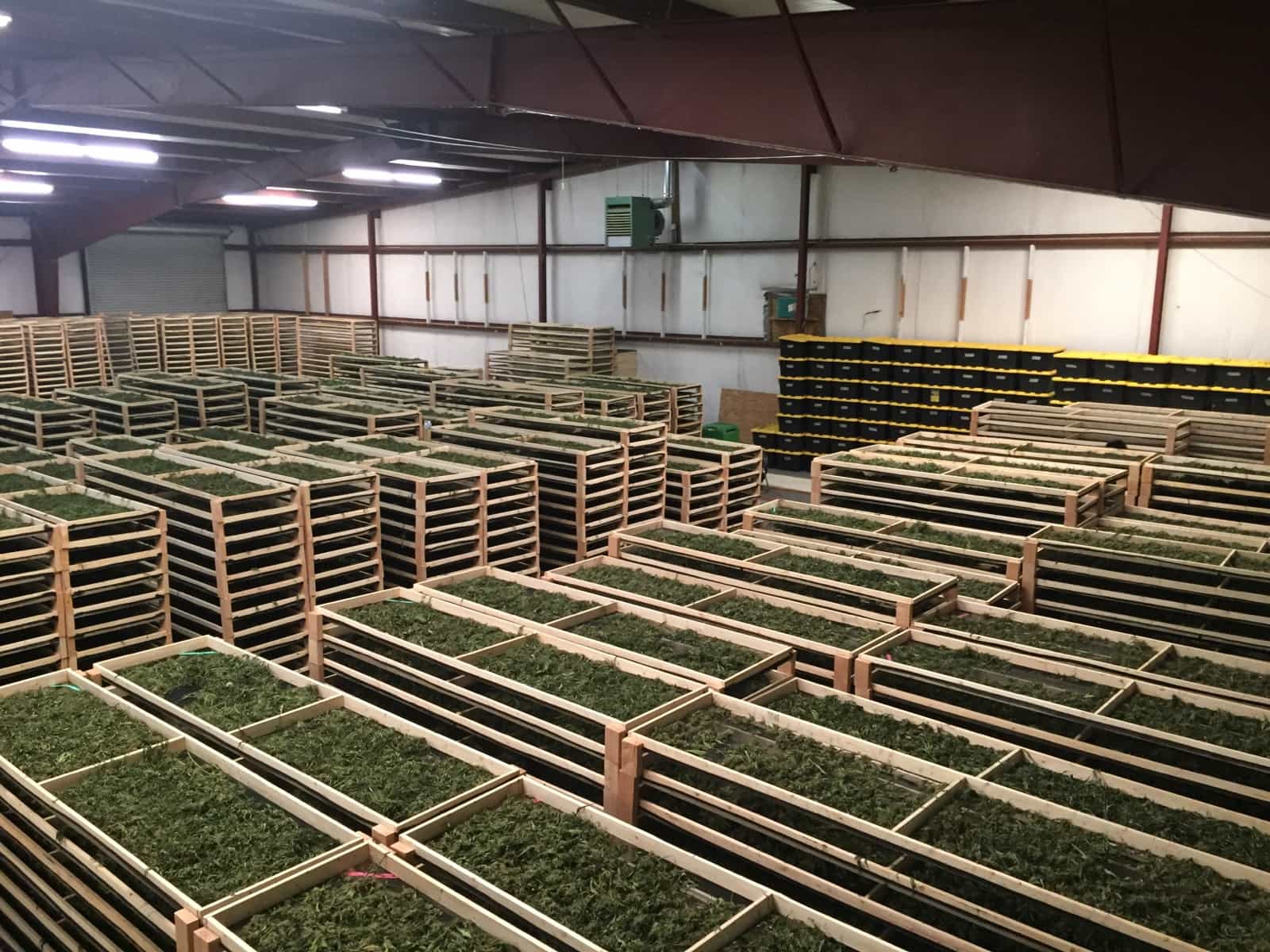Monday 31 October 2016
STRAIN OF THE DAY 11/01/2016: MIDNIGHT (HYBRID)
from
https://www.potbox.com/database/hybrid/midnight/
Washington DC Could Expand MMJ Program in Tuesday Vote
Politics The latest in cannabis legalization including laws and policies, legislators’ views, election coverage, and more.
The District of Columbia Council will vote Tuesday morning on an omnibus medical marijuana proposal that would bring changes to the fledging and often-criticized MMJ program in the nation’s capital. The Medical Marijuana Reciprocity Amendment Act of 2015, introduced last year by Councilmember Yvette Alexander, would allow patients to finally patronize more than one dispensary in the District. The Act would also eliminate the cap on the number of plants cultivators can grow.
Current law forces a patient to sign up to obtain their medicine at only one dispensary. Once committed, that patient is essentially locked into their choice.
Lifting the single-dispensary provision would allow patients to shop based on quality and price. Adoption of the Act would be the first major revision in DC’s MMJ system since it first began in 2013. If approved, the Act will go onto D.C. Mayor Muriel Bowser for signing, and finally to Congress for a mandatory month-long wait.
Passing the Act on Tuesday could send a signal that Washington DC will continue to move forward on cannabis legal reform, despite continued opposition from Congress. In September, Mayor Bowser made an announcement that District patients can increase their medical allowance from two ounces to four ounces every 30 days.
In addition, the Washington DC Department of Health, the agency in charge of the District’s medical marijuana program, recently announced that it will be creating a separate division within the agency “devoted to advancing science, technology and innovation in the fast-paced field of medical marijuana.”
Not everyone is impressed, though.
“While it’s great we can get more medicine, the prices still put medicine out of reach for the average person here,” says Joe Tierney. Also known as The Gentleman Toker, Tierney is a local DC expert on the subject. Many cannabis consumers are trying to do the right thing and buy legal medicine, but at $400-$700 an ounce, it’s just cheaper to buy it on the black market. To put that price in context, cannabis ounces in Colorado and Washington State sell for about half as much, around $200 – $350.
Voters in the District legalized adult-use cannabis back in 2014, of course. But because Congress exerts inordinate control over the DC government, District officials can’t use federal funds to begin creating the internal structures needed to create a taxation and point-of-sale program like Colorado and Washington state already have in place. So a wider customer base and larger industry—which would presumably bring prices down—hasn’t yet been established.
Mayor Bowser’s strong stand on medical marijuana resonates with a majority of Washingtonians, who are also looking forward to voting on a DC ballot initiative on November 8th that would give the District the authority to create a state constitution – and eventually reach for statehood.
“Taxation without representation” is the local battle cry for residents of the District who pay their fair share of taxes, yet are not represented with a vote in Congress. It’s part-and-parcel of what some say is the privilege of hosting America’s most politically elite buildings and international embassies. The slogan is so popular that it’s even on D.C.’s license plates. If this ballot initiative passes, they would be a huge step closer to becoming the legalized state of ‘New Columbia.’
The post Washington DC Could Expand MMJ Program in Tuesday Vote appeared first on Leafly.
from
https://www.leafly.com/news/politics/washington-dc-expand-mmj-program-tuesday-vote
Controversy Erupts Around $10 Million Bust of Legal Marijuana Grow
Over the weekend, 35 people were arrested and $10 million worth of marijuana was seized during a raid at an old airport in Calavaras County, California.
According to the sheriff’s department, the grow operation had been under investigation for the past month due to a reported increase in traffic going and out of the airport.
However, the operation wasn’t illegal; investigators found that the owners had a permit to grow cannabis.
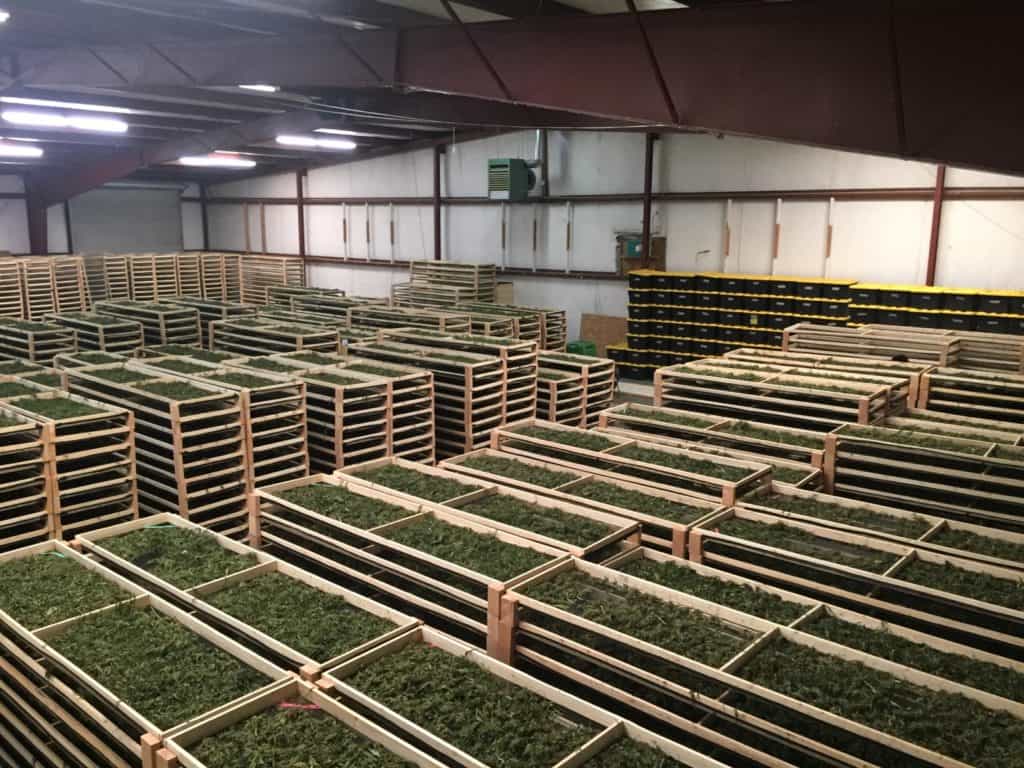
All of this beautiful bud was destroyed.
“They said that they were registered. They paid their $5,000 fee, but again (the owners) are not reading the ordinance,” Sheriff Rick DiBasilio told KCRA. “The ordinance is very specific: you are allowed to grow—that’s it. It has nothing to do with processing, manufacturing, testing, anything.”
According to DiBasilio, it’s the county’s new marijuana laws which are causing problems, but Ata Gonzalez, founder of G FarmaBrands—which consults licensees in Calavaras County and helps fund them in return for product—says that’s not the case.
“G FarmaBrands has sat with the sheriff beforehand, opened dialogue and offereed to help in whichever way possible to bring Calaveras from out of the shadows to be one, if not the one, county to set standards,” Gonzalez explained to HIGH TIMES.
While deputies did find a high-tech marijuana processing operation, in addition to the grow, Gonzales maintains that the bust was politically motivated—not a permit issue.
“What was being done is totally wrong from a wild cowboy sheriff, who got thrown an urgency ordinance to license commercial marijuana cultivation by MMRSA standards.” Gonzalez said. “Millions have been invested into this promise of being licensed and immune from prosecution, and now on his own political motives, this guy has shut down a state-of-the-art harvesting center that was being used to dry, trim, cure and package dry cannabis flower. [He’s] thrown away 2.5 tons of legal cannabis without the licensee having his due process.”
Watch exclusive video footage of the raided grow room below:
You can keep up with all of HIGH TIMES’ marijuana news right here.
from
http://hightimes.com/news/controversy-erupts-around-10-million-bust-of-legal-marijuana-grow/
Mobile Optimization Tips for Cannabusinesses
Welcome to the third and final part of the main marketing lessons for dispensaries and cannabis businesses that I learned from MozCon 2016. In the previous posts, I reviewed how cannabusinesses (and any business, really) can take advantage of reputation marketing and personalization marketing. Today I’ll recap mobile optimization tips that can help cannabis companies better connect with their customers on the platform where they’re spending most of their time: their phones.

The Importance of an Optimized Mobile Experience
Mobile encompasses 65% of the time people spend on digital media. This is important because many businesses tend to focus on their desktop experiences first and mimic that experience for mobile users. The reality is that desktop is becoming more and more secondary in how consumers shop and seek out information. In fact, by 2017 there will be an entirely separate index of search results in Google for mobile, and this index will be prioritized by the search giant.
With these tips, you’ll find a few ways you can make sure your current and potential customers are finding you on mobile and getting the best experience possible once they do.
Don’t Lose People’s Attention
What many companies forget is that we are different people on mobile than we are on desktop. Think about what your screen looks like on your phone vs. your computer. You’ll notice there’s a lot more going on with your computer because it’s easier to open multiple tabs, and we’re typically more patient for content to load. On mobile, both our attention span and patience are dwindled. In fact, 60% of mobile visitors want a site to load in less than three seconds.
This is why site speed is a great place to start in optimizing your mobile website. In terms of design and code, simple is typically better; no one wants to wait for images and clunky code to load. Here are four relatively simple tips a webmaster can follow to help speed things up from the backend:
- Compress the files that make up your website into a zip file. This makes them faster for a browser to load.
- Redirect pages on the site that are 404 errors to a live URL. I’d recommend using Google Search Console to find error pages. It can also be used to diagnose other issues on the site.
- Do your research and find the fastest hosting company for your site. To help, here’s a great guide for hosting companies.
- Detail your image dimensions in the website code so the browser doesn’t have to do the work and take longer to load a page.
These are just a few tactics you can start with, but there are numerous ways to help a website load faster and easier. You can use Google’s PageSpeed tools to help with the process.

Don’t Let People Get Lost or Confused
From where to find your physical location to how to contact you, someone shouldn’t have to spend time getting lost while navigating your site or another map service. Here are a few suggestions to make things easier for them:
- Get your business listed on popular directory sites, including Google and other search engine local listings. As I mentioned in the personalization marketing post of this series, make sure your business name and address format is identical on each site. Consistency across different listings helps get your listings to show up more frequently in search results. Don’t have your name be “Grandmaster Bud’s Emporium of Cannabis” on your Leafly dispensary page but “Emporium of Cannabis Products from Grandmaster Bud” on your Google local listing.
- In your main site navigation, make the links clearly call out what is in that section – strain menu browsing, the blog, about the company, etc. It’s risky to try and be clever with your navigation link text because it can confuse and frustrate your mobile visitors.
- Use click to call buttons when you include your phone number – and clearly call out the best times to call or your hours of operation.
- Show your address and make it easy to click to get directions in a navigation app. Again, how you format your address (abbreviating words, etc.) should be consistent across sites where it’s listed.
- Make contact or opt-in forms simple, easy, and as short as possible. You can A/B test different formats and copy to see what performs best.
- When someone needs to enter information in these forms or anywhere on the site, have the default keyboard match the field the user is filling out. For example, if they need to enter a phone number, make sure the numbers keyboard is what automatically comes up.
There are a number of ways to help your mobile visitors find what they need, but you might be unsure of where to start or what to prioritize. Talia Wolf’s presentation highlighted some great questions to ask yourself that can help you find areas of improvement:
- What does your mobile traffic search for most frequently on your internal site search? This is information that you might want to better emphasize or make easier to find.
- What are the top performing pages on your site for mobile traffic? You can learn from these pages and try to better replicate certain aspects of them across the site.
- Alternatively, you can also look at your pages with the highest drop off to see what about the experience of the page can be improved (and also apply those learnings elsewhere).
Bonus Tip: Talia also shared a Complete Guide to Mobile Landing Page Optimization that you can request for free. It’s full of useful tips and recommendations to get your mobile site in top shape.
Don’t be Intrusive!
Last but definitely not least, don’t force anything upon your mobile visitors. Auto-playing movies or music, giant flashy banners detracting from the main point of the page, and anything else that interrupts the mobile experience is a surefire way to lose your mobile visitors. Plus, all of that tends to increase site load times.
The biggest culprit of mobile intrusion is screen-monopolizing pop-ups. I’m not sure who decided pop-ups taking up the whole screen that don’t allow you to continue reading until you at least click the X were a good idea, but it needs to stop. Usually these pop-ups are asking to subscribe, but interfering with a mobile visitor’s experience like that could actually do the opposite and just cause them to jump ship.
Instead, have less invasive CTAs on the side navigation, at the bottom of a post, or anywhere that doesn’t require someone to take an additional action to NOT opt-in. Plus, Google will begin deprioritizing sites with intrusive interstitials starting January 2017, so you’re also hurting your search engine performance by including these.
Note: Legally required interstitials that cannabis businesses must include to ask a visitor’s age aren’t included in this penalty.
With the conclusion of this series, hopefully the lessons covered in each post provide you some actionable items and strategies you can try now or in the near future. There were a lot of gems from the 2016 MozCon presentations, so feel free to download and explore the session presentations on the Moz site. You can also request detailed notes from Unbounce.

By submitting this form, you will be subscribed to news and promotional emails from Leafly and you agree to Leafly's Terms of Service and Privacy Policy. You can unsubscribe from Leafly email messages anytime.
The post Mobile Optimization Tips for Cannabusinesses appeared first on Leafly.
from
https://www.leafly.com/news/industry/cannabis-dispensary-mobile-optimization-tips-mozcon-2016
Take an In-Depth Tour Behind the Scenes at this Award-Winning Pot Farm
The Brady Bunch
Take an in-depth tour behind the scenes at an award-winning marijuana farm in Oregon that produces pristine, medical-grade cannabis using tried and true cultivation techniques.
Welcome to High Winds Farms
The Pacific Northwest is home to some of the finest growers on Earth. If you can hold your own in this neighborhood, you deserve worldwide respect. Brady Clausen has shown that he’s one of the elite by winning the 2015 Northwest Cannabis Classic, held in Portland, Oregon, last fall (as well as a third-place trophy in the hybrids category), thereby cementing his reputation as one of the best growers in the country.
So how does Brady harvest a bunch of his award-winning weed? It all starts with genetics. There’s no sense working with subpar genetics, he explains—if it’s not top-shelf, it’s not worth keeping. All of his plants must earn the Clausen seal of approval. On my visit to High Winds Farms, he took me upstairs into a large growroom. On wooden shelves sat rows of small plants. Most of the room was stacked with high-output (HO) fluorescent lamps, with one row of high-pressure sodium (HPS) lamps for the mothers. Brady explains that he likes good old-fashioned fluorescent lights and has yet to find anything better. Looking at the plants, I’d have to agree. Their internode spacing was spot on, with short stems and large, healthy leaves. I could tell by the deep-green color that these plants were lovin’ life!
The Vegetative Stage
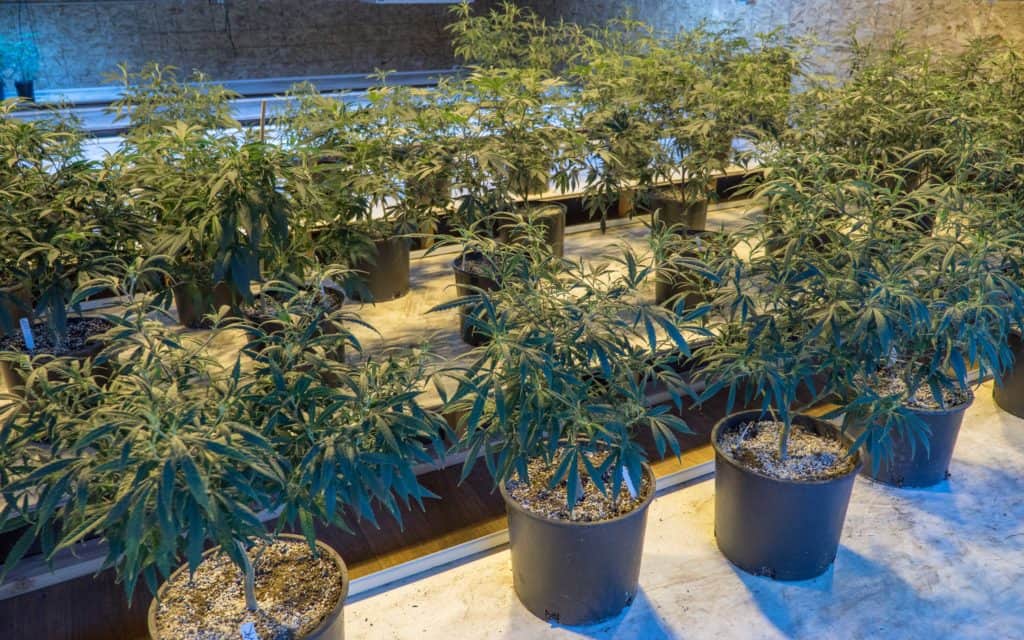
Give vegging plants plenty of space to expand. (Photo by StinkBud)
Brady keeps a row of mother plants next to the teens. From these, he takes cuttings and places them in standard rockwool cubes. He dips the clones in rooting gel first; then it’s off to the Thunder Dome to pop roots. Brady prefers soil throughout the entire grow cycle: He uses a high-quality local soil but says that any top-shelf soil will do. The plants are transplanted several times throughout their lifespan. The first stage is in standard 4-inch square pots, where they spend a week or two. Then they’re transplanted into 1-gallon containers until the plants reach about 1 foot tall. They spend their rebellious teens in 3-gallon containers (telling Brady, “Fuck off! You can’t make me flower!”) before their final move into 20-gallon pots. Brady is careful not to stress the plants during each transplant; he allows them time to adjust to their new home before switching them over to flower.
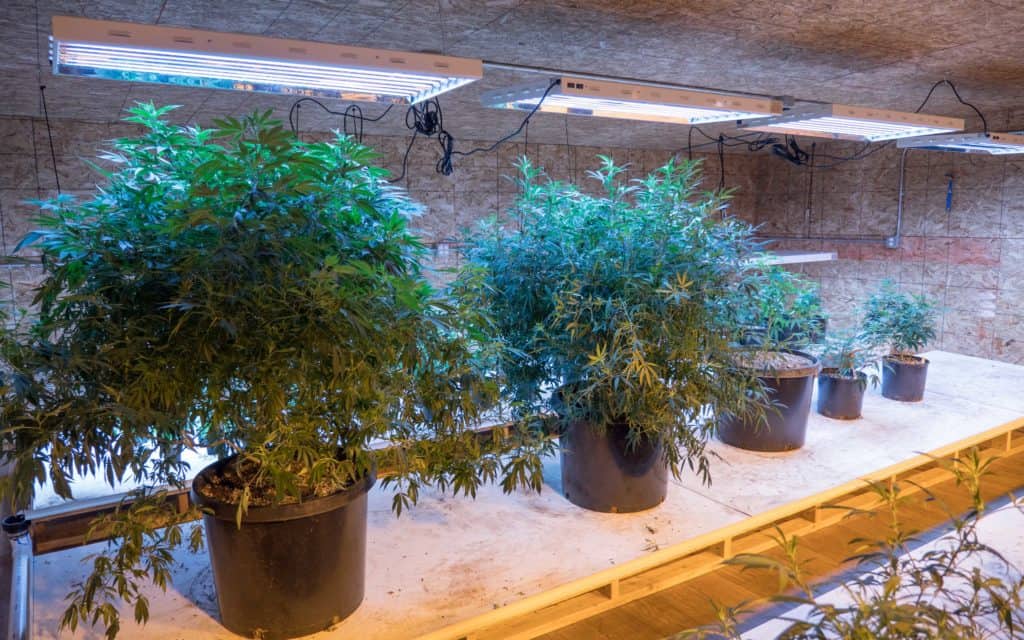
Mother plants produce a continuous supply of rooted clones. (Photo by StinkBud)
The Flowering Stage
After the vegetative stage, the girls go into one of four massive flowering rooms. It’s so bright in there that it feels like an indoor Arizona! The ceiling is lined with 1,000-watt HPS lamps with integrated ballasts. Everything is controlled by computer; Brady showed me how he can adjust the timing of every room, all from one place. He can dim the lights to whatever intensity he chooses and also set them to slowly reach the 12-hours-on/12-hours-off cycle over a couple of weeks, so as not to shock the plants. It makes sense, when you think about it: How would you like to have a 1,000-watt light hanging inches above your head and then, instead of waking up to a phone beeping, get the equivalent of being slapped by a small sun?
Each flowering room has its own dedicated commercial air conditioner and dehumidifier—we’re talking A/C units the size of a small car. Without air-cooled lights, it’s critical to have enough A/C to keep the rooms under 80°F. This isn’t hard during the cold Oregon winters, but it can be a challenge on those 100°F summer days! The humidifiers are set to maintain the rooms at 60% humidity. Brady says this is the optimum setting for keeping his plants happy and mold-free.

Flowers forming .(Photo by StinkBud)
The plants are lined up in rows by strain. This makes harvesting them much easier, as Brady can take down entire rows while leaving the rest of the room to finish. He has two layers of netting running the entire length of each room. The plants love it, but it makes walking through the aisles a pain in the ass. Every time I turned around, I felt like a bug in a spider web. I mean, really: How many times can someone get his head stuck in a net? You’d think I’d have learned after the 10th time!
Training Day
The netting allows the plants to be trained like a well-oiled gimp. When I entered the flowering room, I felt like Dorothy in The Wizard of Oz walking into the castle for the first time. I really wished I had my magic slippers with me—nothing but wall-to-wall joy! It felt like some kind of bizarre stoner dream where any minute you think the cops are going to knock on the door of your van and tell you to move it away from the river. Each plant has a hose with a drip ring attached; the hose leads to a reservoir with a pump, where Brady keeps the perfect mix of water and nutrients.
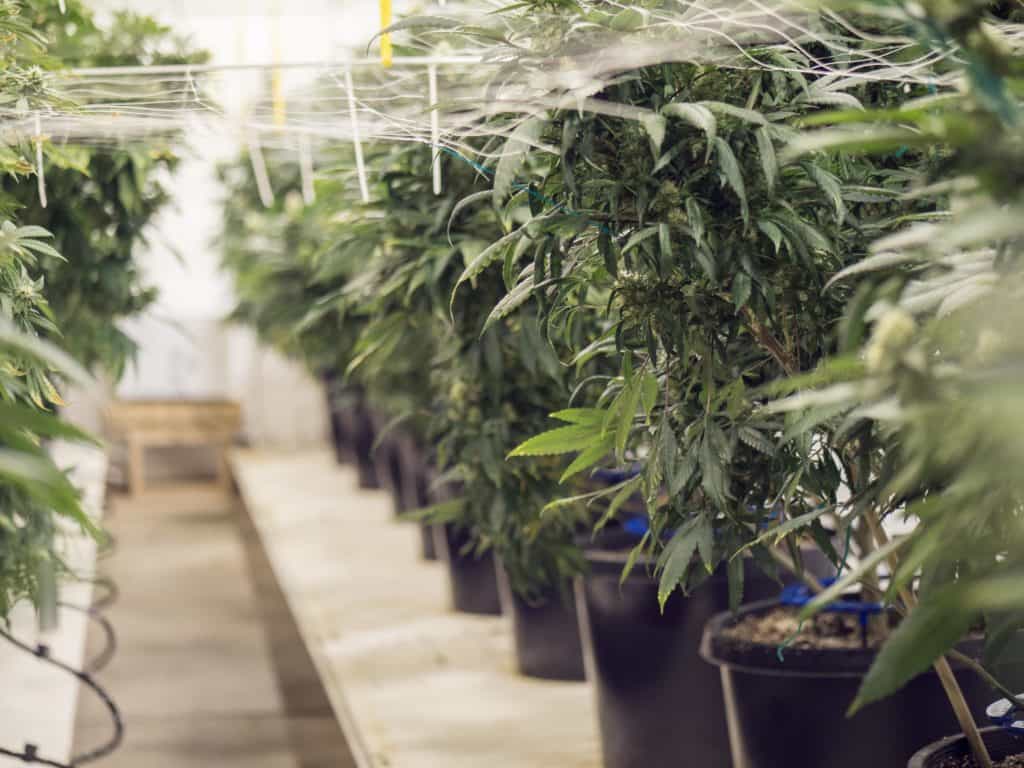
Orderly rows. (Photo by StinkBud)
I asked Brady how he had his water timers set, and was surprised when he said that he didn’t use them. As good as a timer-based system is, he explained, it’s not perfect—the plants will need more or less water throughout their grow cycle, and sometimes the timers just don’t get it right: What works great one day may starve the plants a week later. Brady insists that nothing beats the human eye—or, I should say, the human hand, since he prefers lifting the plants to see if they need water. If the plant feels light, then he knows it’s time to crank up the pumps. He’s also able to monitor the plants to make sure they aren’t overwatered. If the pots are so heavy that he can’t lift them, he’ll back off the all-you-can-eat buffet a little. This technique requires years of experience to master. It’s not something you can learn just by reading a book; you have to do it, over and over. But once you have it wired, it’s a surprisingly quick and easy way to check your plants.
Feeding Time
The plants are watered with a mixture of clean water and nutrients. There’s no need for a reverse-osmosis (RO) machine up here, where our water is cleaner than our minds. Brady prefers the Botanicare line of nutrients. He says they produce a better taste, and if you’ve ever had the pleasure of smoking his weed, you’d wholeheartedly agree. Brady takes great pride in the overall flavor of his herb, and you can tell after the first mouthwatering puff: His buds burn smooth and leave a clean, white ash.

Drippers feed plants individually. (Photo by StinkBud)
Brady is currently using the standard Botanicare formula of Base, Tea, Grow/Bloom, Hydroguard, Hydroplex and Cal/Mag. He adjusts the ppm to different amounts depending on the stage of growth. As the plants phase from the veg stage to flower, he cuts down on nitrogen while increasing potassium and phosphorus. Brady is adamant about using Hydroguard to inoculate the soil with the friendly bacteria Bacillus. He also uses Pure Blend Tea to enhance the aroma and flavor—not to mention that it helps to feed the beneficial bacteria.
On the wall outside each growroom is a large whiteboard with a detailed rundown of the room. The correct ppm, nutrients and schedule are all laid out. Next to the nutrient table are the reservoirs; each room has its own unique mix of nutrients and water. Brady spends a great deal of time adjusting the ratio to perfection. He starts out by keeping the ppm low, using Botanicare’s vegetative formula, and slowly raises it over time. He changes from the veg mix to the bloom formula during flowering. The last few weeks, he drops the ppm to flush the plants of any excess nutrients. When you look at Brady’s buds, they have a wonderful light-green/gold tone to them. Of course, that’s if you can see through all the trichomes!
Time to Harvest
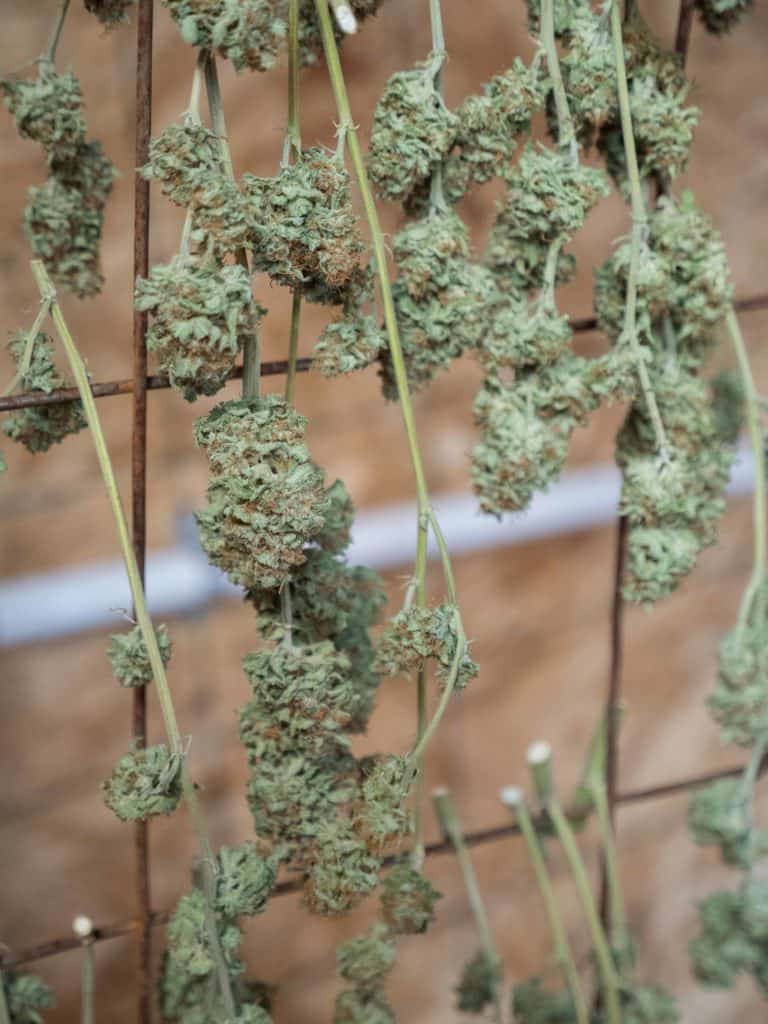
Hang drying works best. (Photo by StinkBud)
Brady observes his plants closely, watching for the perfect time to harvest. He doesn’t rely on a calendar to decide; he uses his eyes. He examines the trichomes to see if the crystals are turning from cloudy to amber. Only when the plants meet Brady’s strict requirements are they ready to harvest.
On that day, everything is cut down and all the fan leaves are trimmed off and mulched. The plants are hung in the drying room on their way to the finish line. The drying room has a large dehumidifier with fans blowing on the hanging plants. Brady prefers a nice, slow dry; he says the buds taste better if the plants have a chance to use up the final nutrients trapped within the cells. He adds that the only thing you have to watch out for is mold: It’s important to inspect the buds and make sure they don’t start to rot. (Is there anything worse than bud mold? Every outdoor grower in the Northwest has at least one horror story to tell!)

Trimming in process. (Photo by StinkBud)
Brady checks the drying plants frequently. He bends the stems and, when they snap, he knows they’re ready for the final trim. Brady has a crew of hand trimmers jamming away to music, with the sound of clip-clip-clip always in the background. It almost sounds like little crickets chirping away, hoping to get laid. When I asked him why he prefers hand trimming when he could obviously afford the best machine trimmer, Brady replied: “Why spend all that time and money growing the perfect buds, only to ruin them at the last minute?” Although trimming machines are fast, they tend to damage the buds and knock off many of the trichomes, he added. Basically, if you grow the best bud, you need the best trim job.
Winning Weed
Brady’s team is top-notch: The care his trimmers lavish on every bud is simply amazing. Years of experience allow his crew to trim to perfection. You won’t see any kickstands or crow’s feet on these buds—nothing but sugar-coated calyxes await the lucky smoker! After the buds are trimmed, they’re placed in glass jars for a couple of weeks to allow them to cure properly. Brady burps each jar a few times a day, letting the excess moisture escape. Only when the buds pass his final inspection are they sent off to the distributor.
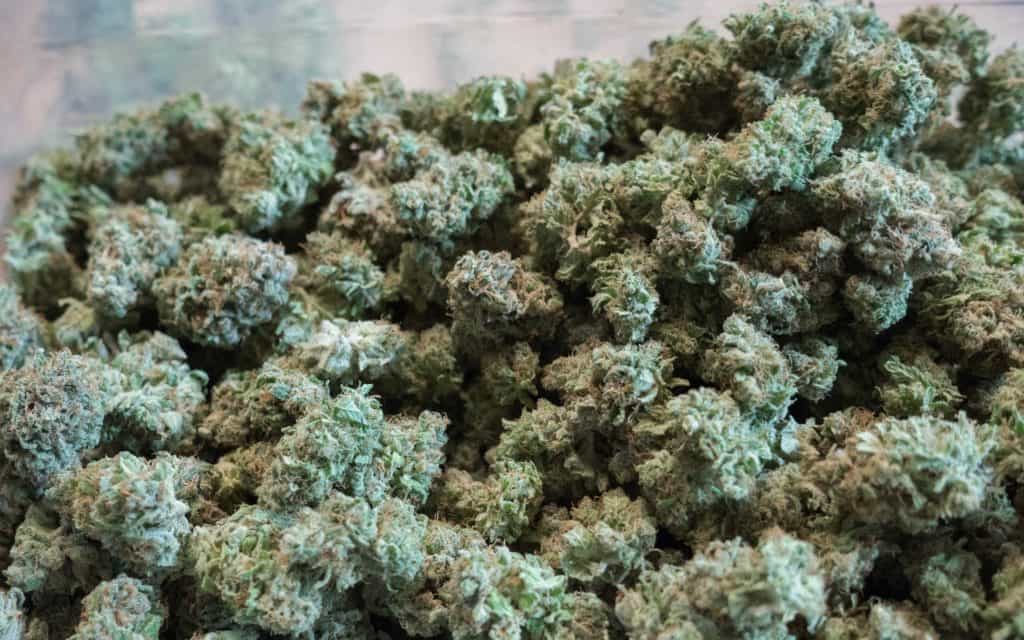
Behold Brady’s buds! (Photo by StinkBud)
There are a lot of master growers here in the Great Pacific Northwest. Alaska, Washington and Oregon have always been at the forefront of the cannabis revolution—and when these master growers get together and choose Brady’s bud as the best, what does that tell you? Brady Clausen is not just your average grower: His flowers are at the top of the bud chain. If you’re ever in Oregon, stop by one of the local dispensaries and try some of Brady’s bud for yourself—just look for “High Winds Farms” on the label. I currently have some of his award-winning Blackberry in front of me right now! It looks completely white, shimmering in the sunlight. It’s almost too pretty to smoke! I said almost ….
 (Photo by StinkBud)
(Photo by StinkBud) (Photo by StinkBud)
(Photo by StinkBud) A trellis keeps growing tops closer to their light source. (Photo by Stinkbud)
A trellis keeps growing tops closer to their light source. (Photo by Stinkbud)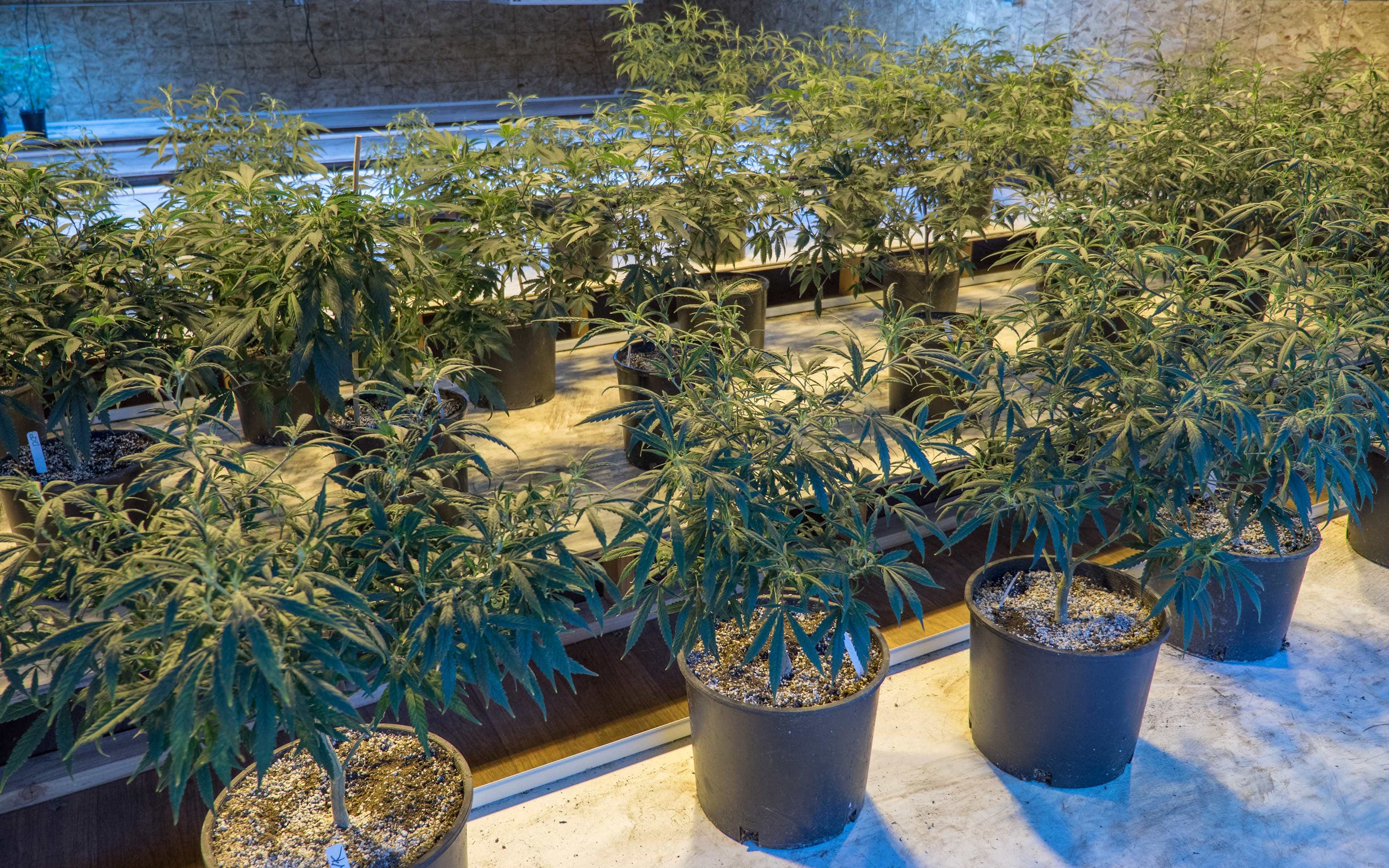 Give vegging plants plenty of space to expand. (Photo by StinkBud)
Give vegging plants plenty of space to expand. (Photo by StinkBud)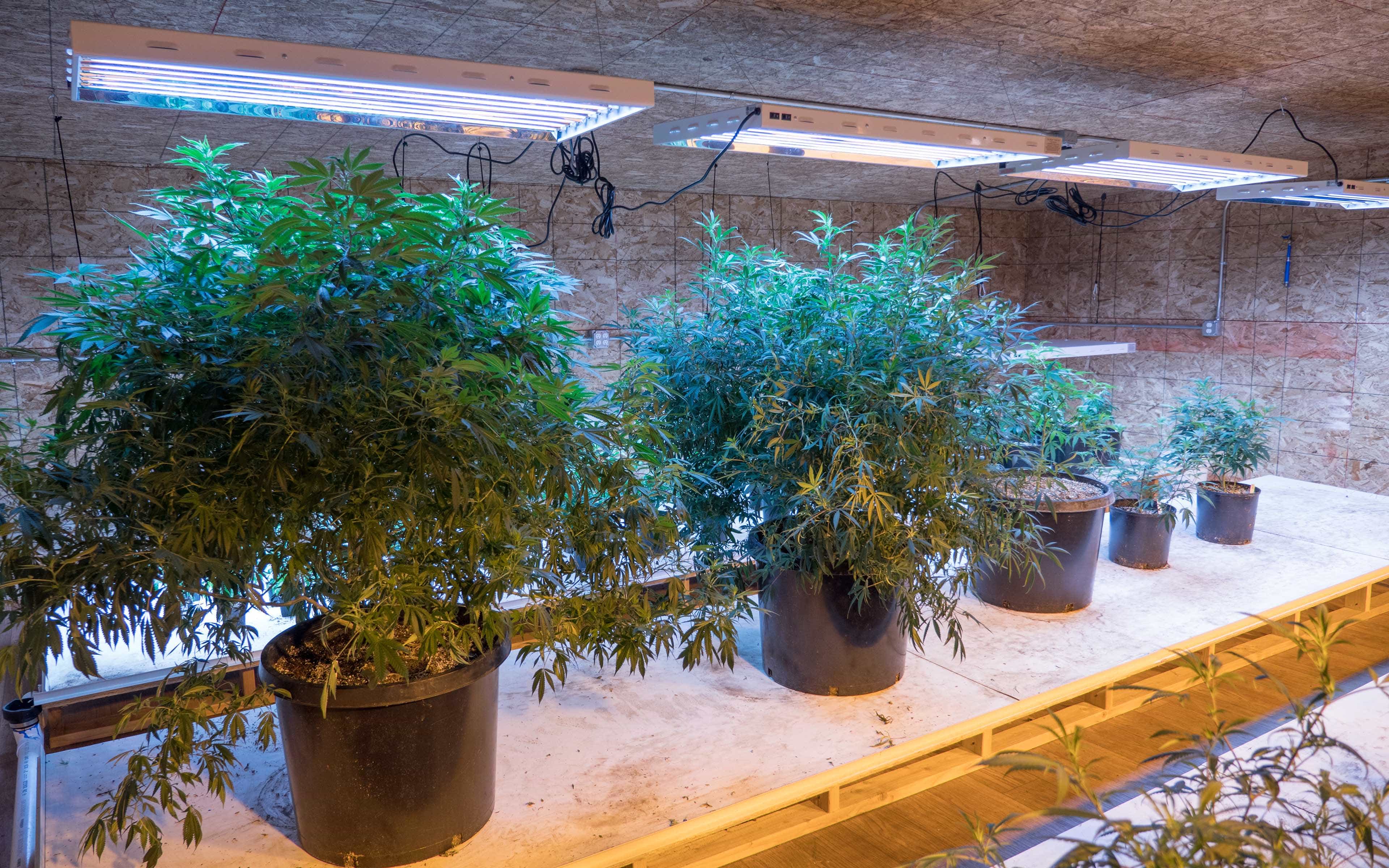 Mother plants produce a continuous supply of rooted clones. (Photo by StinkBud)
Mother plants produce a continuous supply of rooted clones. (Photo by StinkBud) Flowers forming .(Photo by StinkBud)
Flowers forming .(Photo by StinkBud)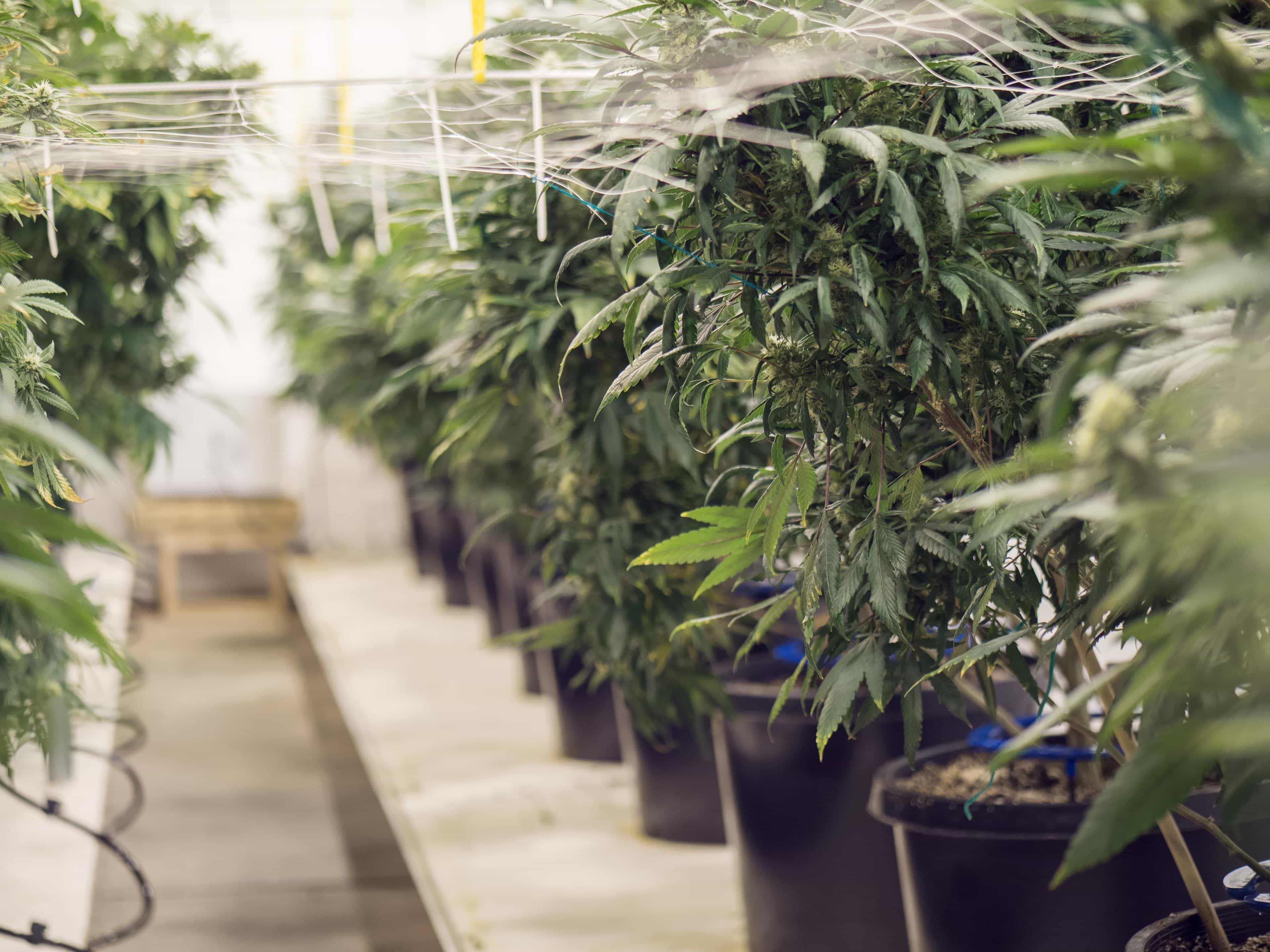 Orderly rows. (Photo by StinkBud)
Orderly rows. (Photo by StinkBud)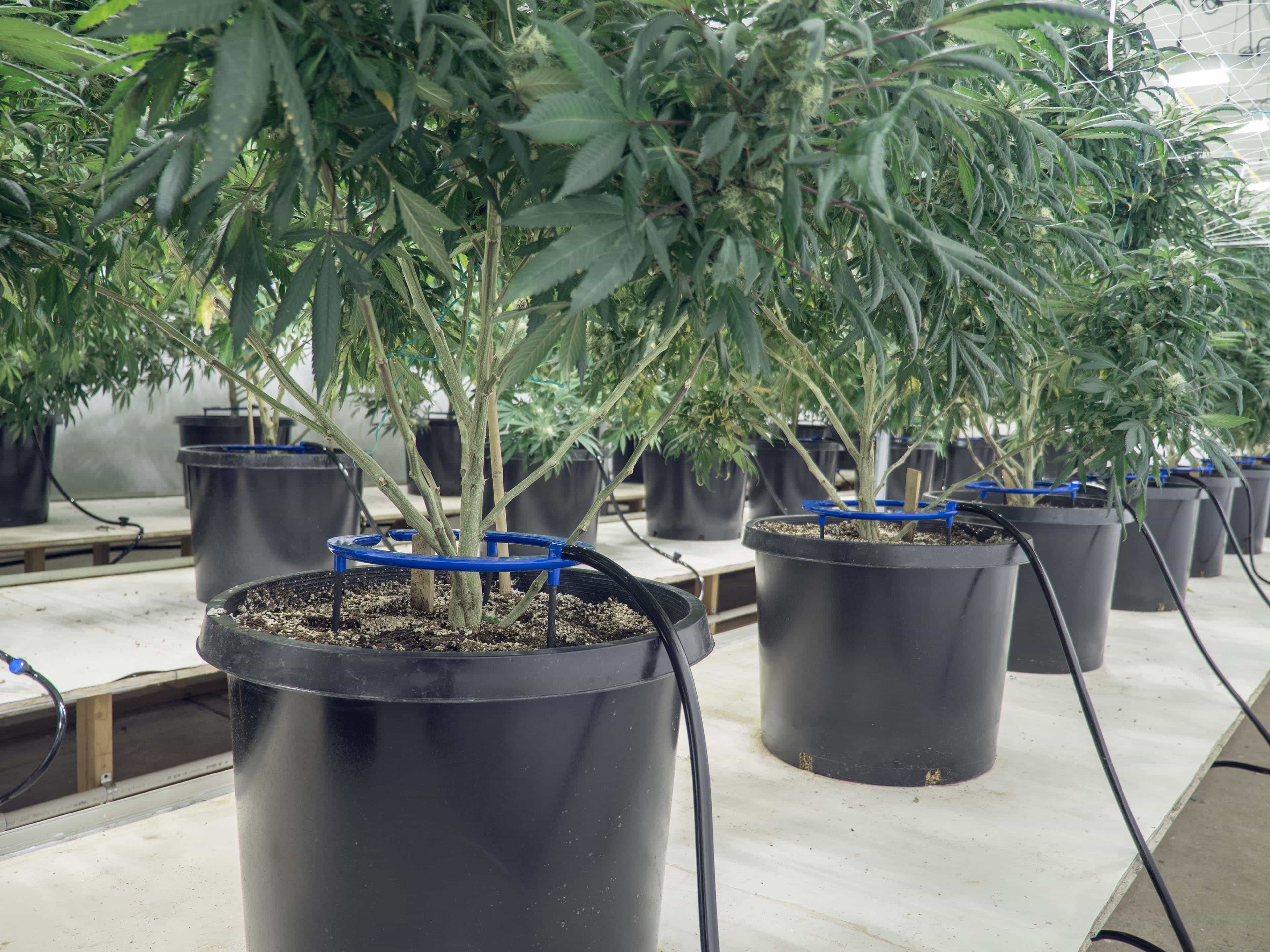 Drippers feed plants individually. (Photo by StinkBud)
Drippers feed plants individually. (Photo by StinkBud) Hang drying works best. (Photo by StinkBud)
Hang drying works best. (Photo by StinkBud) Trimming in process. (Photo by StinkBud)
Trimming in process. (Photo by StinkBud) (Photo by StinkBud)
(Photo by StinkBud)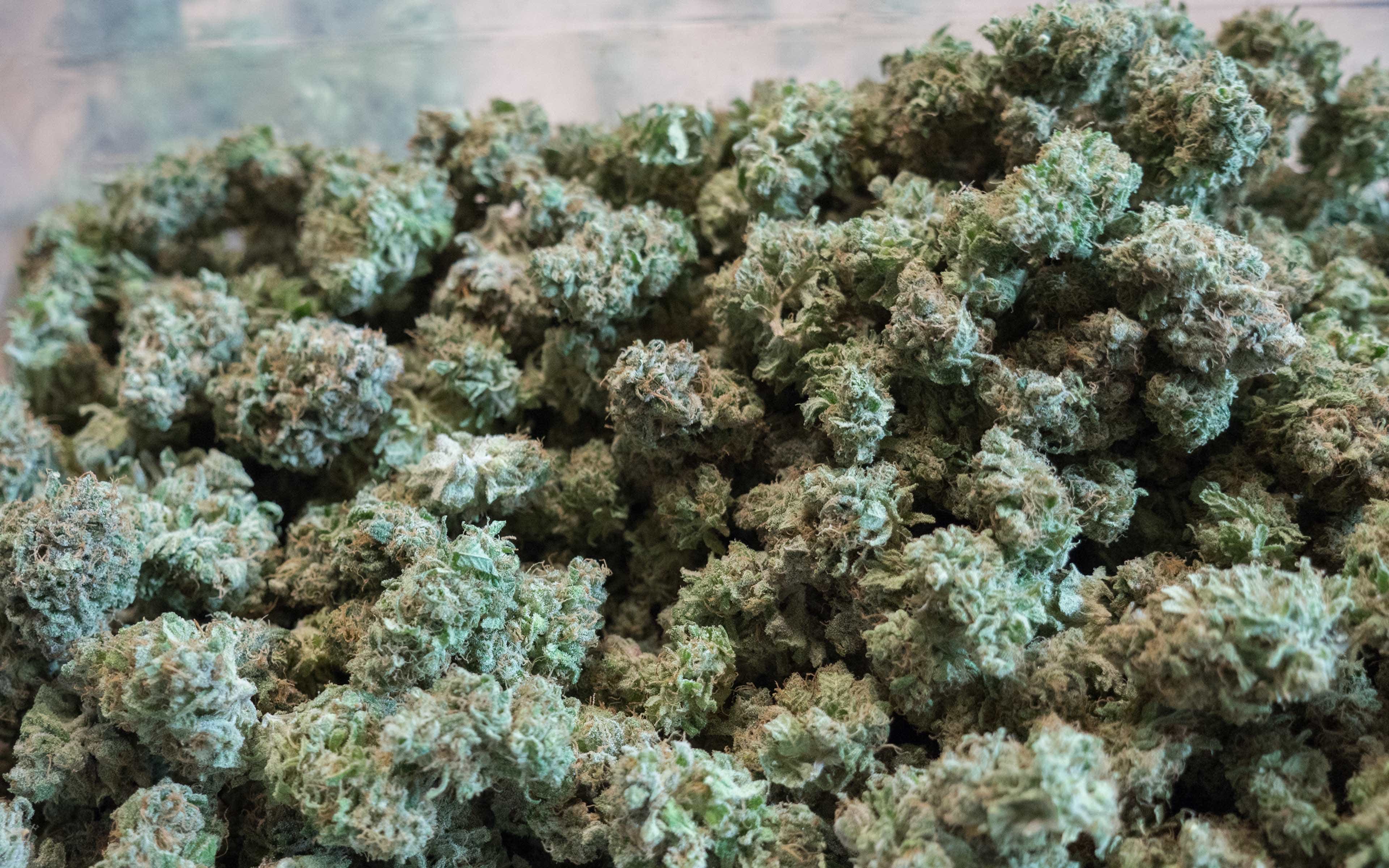 Behold Brady's buds! (Photo by StinkBud)
Behold Brady's buds! (Photo by StinkBud) (Photo by StinkBud)
(Photo by StinkBud)
For all HIGH TIMES’ grow coverage, click here.
from
http://hightimes.com/grow/take-an-in-depth-tour-behind-the-scenes-at-this-award-winning-pot-farm/
Why You Shouldn’t Buy Cannabis on the Streets of Prague
Food, Travel, & Sex Everyday cannabis tips about travel destinations, recipes, and how marijuana can enhance your sex life.
Looking to spend some time in Europe, enjoy its rich history, and sample some quality cannabis while you’re at it? The Czech Republic and its stunning capital of Prague is one of your best bets.
Prague: The good and the bad
Cannabis is incredibly popular in Czechia, and in Prague it’s a familiar aroma as you explore the city streets. The upshot? The capital’s busiest intersections and tourist spots are occupied by suspicious-looking dealers. While strolling through Wenceslas Square, the city’s largest and most famous plaza, you hear the question Want some weed or hash? almost constantly.
Our advice? Never engage in conversation with these people or even think about buying something from them. You’ll likely be disappointed.
According to Lubos Pirkl, who used to study math and physics in Prague, buying cannabis on the street can be a nightmare. “Before moving here, I lived in a village and grew my own cannabis in a greenhouse,” he recalled. “My favorite strain was Durban Poison, an early-flowering sativa that used to be extremely popular with outdoor growers in Czechia before autoflowering strains took over. One night, out of pure curiosity, I decided to try some hashish that an Arab guy offered me in a busy tourist location. It was very expensive, underweight, the taste was awful, and it made me almost sick. When I examined it thoroughly at home, I realized I had bought hash mixed with asphalt.”
Street dealers are the most obvious sign that cannabis sales are still illegal in Czechia. But while selling is frowned upon, possession and consumption are widely tolerated. So while all cannabis sales in the country are technically illegal, some are safer than others. Savvy consumers use a safer—yet still not completely legal—means of obtaining high-quality cannabis for a reasonable price. Dozens, if not hundreds, of clubs and bars in the city sell cannabis under the table for around $10 a gram.
Cannabis laws in the Czech Republic are relatively liberal, yet they may be a bit confusing for foreign visitors. While the consumption of cannabis is legal, possession of less than 10 grams is considered a minor offense and carries a small fine ranging from $10 to $50. Possession of more than 10 grams or any form of distribution is subject to criminal penalties.
There’s no shame in being a cannabis consumer in the Czech Republic, so you don’t have to worry about negative reactions. Most friendly looking Czech people, especially if they’re under 40, are more than happy to point you in the right direction. Young Czechs are the biggest cannabis consumers in Europe per capita and—also important—speak good English.
Sharing is caring
Another viable option is to follow your nose. A group of friends smoking a joint—or rolling one—outside of a pub are usually quick to share, as well as direct you to the nearest source. It’s even possible they’ll provide some of their stash as a present.
As a general rule, don’t insist on paying for cannabis unless you are asked to do so. Czechs are proud growers and members of the cannabis community, and many of them hate to see herb being exchanged for money.
Don’t forget the countryside
If you ever end up outside Prague—and you should, as the Czech countryside is rich with natural and cultural beauty—you’ll notice the indoor-grown plants of the city will eventually be replaced by outdoor grows. Many consumers prefer outdoor-grown cannabis and claim that the Czech climate—long taken advantage of by hemp farmers—combined with top quality genetics create more potent and better-tasting plants compared to cannabis grown under lights. A great example is the South Moravian Region, the sunniest and hottest part of Czechia, where both the country’s best wine and the best outdoor cannabis are grown.
The post Why You Shouldn’t Buy Cannabis on the Streets of Prague appeared first on Leafly.
from
https://www.leafly.com/news/food-travel-sex/shouldnt-buy-cannabis-streets-prague











